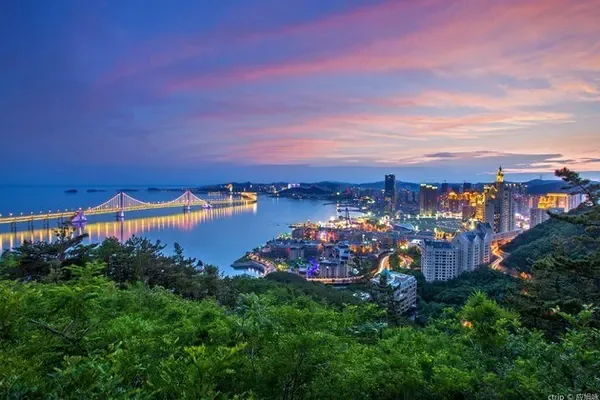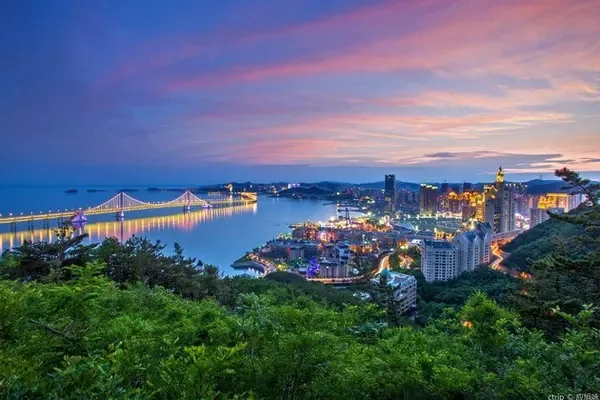The Shenyang Palace Museum in Liaoning is one of the places of interest that most tourists who come to Shenyang will come to pay their respects. As one of the two most complete palace complexes in China, the Shenyang Palace Museum is a national key cultural relic protection unit. Although the Shenyang Forbidden City is not as large as the Forbidden City in Beijing, its unique history, geographical conditions and strong Manchu characteristics have attracted many tourists from home and abroad in recent years.

On May 12, 2005, the reporter and his party went to Shenyang to pay their respects to this famous Manchu royal palace. Since it is not a holiday, it is really pleasant to wander in the Palace Museum where there are relatively few tourists.

The current Shenyang Forbidden City has two gates. One of them serves as the exit of the Forbidden City; the gate is also a parking lot. On the wall outside the door, there is a white marble with gold characters on a white ground, on which are four golden characters of "Shenyang Imperial Palace" inscribed by Mr. Guo Moruo. The other is the main entrance of the Palace Museum. The plaque of "The Palace Museum" above the gate is very eye-catching.

Data records: The Shenyang Imperial Palace was first built in 1625 AD. It was the imperial palace founded by Qing Taizu Nurhachi and Qing Taizong Huang Taiji before the Qing Dynasty entered the customs. The ancestor Fulin of the Qing Dynasty ascended the throne here and proclaimed himself emperor. The Shenyang Imperial Palace has undergone many large-scale renovations and has now been turned into the Shenyang Imperial Palace Museum.

Because the streets in the old city of Shenyang are in the shape of a "well", the Forbidden City is located in the center of the "well"-shaped street, covering an area of 60,000 square meters, with 114 ancient buildings. There are more than 90 buildings and more than 300 rooms.

The Shenyang Imperial Palace can be divided into three parts according to the architectural layout and construction sequence: the East Road is the Dazheng Hall and the Ten Kings Pavilion built during the Nurhachi period; the Middle Road is the Dazhong Que built during the Qing Taizong period, including the Daqing Gate and the Chongzheng Hall , Phoenix Tower and Qingning Palace, Guansui Palace, Yanqing Palace, Qifu Palace, etc.; West Road is the Wensu Pavilion built during the Qianlong period. The entire imperial palace is full of pavilions, majestic palaces, carved beams and painted buildings, magnificent.

In particular, the Dazheng Hall and Chongzheng Hall with golden dragons and pillars in the Shenyang Imperial Palace, the Ten Kings Pavilion lined up like geese, the Qingning Palace with a pocket room of the Wanzi Kang, the simple and elegant Wenshuo Pavilion, and high-rise buildings such as the Phoenix Tower, are among the most famous Chinese palaces. It is unique in the history of architecture; the architectural style of "high palace and low palace" full of Manchu sentiment is even more "no semicolon".

The palace buildings in the Shenyang Imperial Palace have their own characteristics. The Chongzheng Hall is in the middle of the front yard of the middle road, commonly known as the "Jinluan Hall", and is the most important building of the Shenyang Imperial Palace. The whole hall is of wooden structure, with five rooms and nine purlins in a hard mountain style, with partition doors, front and rear corridors, and stone railings.

The pillars of the palace body are square, and there are water-spitting chi heads under the pillars, and the roof is covered with yellow glazed tiles inlaid with green trimmings; the pillars are round, and a carved dragon is connected between the two pillars, and the dragon head sticks out of the eaves. In addition, the dragon's tail goes straight into the palace, which is a perfect combination of practicality and decoration, adding to the imperial spirit of the palace.

This hall is the place where Emperor Taizong of the Qing Dynasty handled important affairs in the daily court. In 1636 AD, the grand ceremony of changing the country's name to Qing Dynasty was held here. The Phoenix Tower at the north head of Chongzheng Hall, with three floors, was the tallest building in Shengjing City at that time.

Dazheng Hall, commonly known as Octagonal Hall, was first built in 1625. It is an important palace built by Qing Taizu Nurhachi, and it is the most solemn and sacred place in the Shengjing Palace. It was called Da Yamen at first, and it was named Dugong Hall in 1636, and later changed to Dazheng Hall. The octagonal double eaves are pointed, with corridors on eight sides, under which is the base of Xumizuo.

The top of the octagonal hall is covered with yellow glazed tiles, inlaid with green trimmings, and the top of the flame bead is in the middle. There are eight iron chains around the top of the treasure that are connected to the warriors. The two bright pillars in front of the hall each have golden dragon coiled pillars. Inside the hall are Sanskrit smallpox and subduing dragon caissons. There are thrones, screens, incense burners, incense pavilions, crane-style candlesticks, etc. in the hall. This hall is the place where Qing Taizong Huang Taiji held major ceremonies and important political activities. In 1644 (the first year of Shunzhi), Emperor Fulin ascended the throne here.

The Ten Kings Pavilion is located on both sides of the Dazheng Hall in a horoscope, which is a reflection of the Manchu Eight Banners system in palace buildings. This architectural layout is only seen in the history of ancient Chinese palace architecture. The five pavilions on the east side are Zuoyiwang Pavilion, Xianghuangqi Pavilion, Zhengbaiqi Pavilion, Xiangbaiqi Pavilion, Zhenglanqi Pavilion from north to south; the five pavilions on the west side are Right Wingwang Pavilion, Zhenghuangqi Pavilion, Zhenghongqi Pavilion, Inlaid red flag pavilion, inlaid blue flag pavilion. It was the place where Baylor, the main banner of the Eight Banners, and the ministers discussed and handled government affairs in the early Qing Dynasty.

The Shiwang Pavilion, where the monarch and his ministers work together in the palace, is rarely seen in history. From the architectural point of view, the Dazheng Hall is also a pavilion, but it is larger in size and more ornately decorated, so it is called a palace. The architectural pattern of the Dazheng Hall and the 10 pavilions arranged in a figure-eight shape is derived from the tent halls of ethnic minorities. These 11 pavilions are the embodiment of 11 tents. The tent can be moved freely, but the pavilion is fixed, which shows a milestone in the development of Manchu culture.

Wensu Pavilion was built in 1782 (the forty-seventh year of Qianlong). It was specially built to store "Wensu Pavilion Siku Quanshu", and "Ancient and Modern Book Collection" is also stored in the pavilion. Behind the pavilion is Yangxi Zhai, and there are Chaoshou corridors in the east and west, where the emperor studied.

The Phoenix Tower is built on a 4-meter-high green brick platform, with a three-drop Xieshan-style corridor, covered with yellow glazed tiles, and inlaid with green trimmings. This building is the tallest building in Shengjing, so it is known as "Fenglou Xiaori" and "Fenglou Guanta", one of the "Eight Scenes of Shengjing". On the Phoenix Tower, there is a plaque of "Purple Qi Comes from the East" inscribed by Emperor Qianlong himself.

The Shenyang Palace Museum is not only a complex of ancient palace buildings, but also famous for its rich and precious collections at home and abroad. The Forbidden City displays a large number of palace cultural relics left over from the old palace, such as the sword used by Nurhachi.

In particular, the courtyard of the Forbidden City is comfortable and quiet, with promenades, small pavilions, flowers, plants and trees complementing this classical palace complex. Especially in the bright spring season, the colorful and blooming flowers and plants always seem to radiate vitality for this ancient palace. (Photo: Feng Ganyong)


